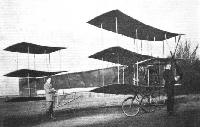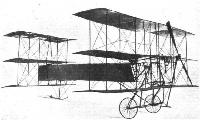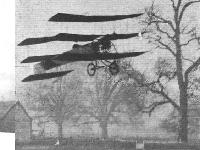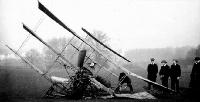
Варианты
- Avro - Triplane I - III - 1909 - Великобритания
- Avro - Triplane IV - 1910 - Великобритания
Avro Biplane и Triplane
<...>
Потерпев неудачу с бипланом, Роу решил создавать триплан в партнерстве с Дж. Прествиком, конструктором мотора JAP. Но начавшиеся работы по постройке нового самолета пришлось прекратить из-за нехватки денег. Тем не менее, вскоре Роу продолжил создание нового триплана. Сначала конструктор поставил на аппарат мотор JAP мощностью 6 л. с, а потом - 9-сильный JAP. В результате появился Avro Triplane № 1 (Roe I Triplane) - неуклюжий хрупкий аппарат с тремя крыльями и горизонтальным хвостовым оперением. Фюзеляж треугольной формы обшивки не имел, внешние части крыльев длиной 1,52 м складывались для удобства хранения и транспортировки аппарата.
Собранный в Эссексе самолет получил имя "The Blues" - в честь компании брата Роу, обеспечившей финансовую поддержку. На самолете было выполнено несколько подскоков, первый - 5 июня 1909 года. По мере обретения Роу навыков техники пилотирования, высота полетов увеличивалась, и 23 июля он поднялся на высоту 274 м. К этому времени на аппарате уже стоял мотор Antoinette мощностью 24 л.с. В октябре на аппарате удалось выполнить несколько полетов, но уже 24 декабря Triplane № 1 разбился. Было построено еще три таких триплана с двигателями JAP мощностью 9,20 и 35 л.с.
Следующим изделием Роу стал Triplane №2 (Roe II) с мотором JAP мощностью 35 л. с, который, несмотря на наличие мотора большей мощности, смог подняться лишь на высоту 183 м.
Далее Роу приступил к постройке более мощного самолета, но снова - триплана. Двухместный Mercury имел фюзеляж с фанерной обшивкой, оснащался 35-сильным мотором Green в комбинации с тянущим двухлопастным воздушным винтом (на ранних аппаратах стояли четырехлопастные винты).
Как конструктор Роу быстро прогрессировал, результатом чего стал самолет Triplane № 3 (Roe III). Шесть таких аппаратов построили в Манчестере. Подобно Mercury, новый триплан был двухместным, но отличался более прочной конструкцией. Управление по крену осуществлялось элеронами, а не перекосом плоскостей крыла, а для управления по тангажу использовались рули высоты. Второй и третий самолеты Triplane № 3 с моторами Green и JAP соответственно были направлены на авиационный слет в Блэкпуле в июле - августе 1910 года, и оба сгорели во время пожара в процессе транспортировки(причиной послужили искры из дымовой трубы паровоза). Роу доставил в Блэкпул четвертый аппарат, спешно собранный из разных запасных частей в Манчестере.
<...>
ТАКТИКО-ТЕХНИЧЕСКИЕ ХАРАКТЕРИСТИКИ
Avro Triplane N3 (Roe III)
Тип: двухместный триплан
Силовая установка: один мотор жидкостного охлаждения Green мощностью 35 л. с. (26 кВт)
Характеристики: максимальная скорость на уровне моря 64 км/ч
Масса: макс, взлетная 249 кг
Размеры: размах верхнего и среднего крыльев 9,45 м, нижнего - 6,10 м; длина 7,01 м; высота 2,74 м; площадь крыльев 33,63 .м
Описание:
- Avro Biplane и Triplane
- Flight, July 1925
THE ORIGINAL AVRO TRIPLANE FOR SOUTH KENSINGTON MUSEUM
Фотографии
-
Мировая Авиация 38
На Roe I Triplane летчик сидел сразу за топливным баком, установленным на стойках над фюзеляжем.
-
Aviation Historian 15 / P.Jarrett - Mr. Cody & Mr. Roe (2)
A contemporary tinted postcard showing Roe at the controls of his triplane in September 1909.
-
Jane's All the World Aircraft 1980 / Encyclopedia of Aviation - Aircraft A-Z - v2
1909 A.V.Roe triplane in the Science Museum, London.
-
Aviation Historian 15 / P.Jarrett - Mr. Cody & Mr. Roe (2)
Roe sits in his nearly complete triplane at Lea Marshes in early 1909. The machine has been temporarily fitted with the 6 h.p. JAP two-cylinder vee engine from Roe’s original biplane, pending the delivery of something more powerful from Tottenham-based JAP.
-
Aviation Historian 15 / P.Jarrett - Mr. Cody & Mr. Roe (2)
Roe carrying a passenger in the third Roe III at Blackpool on August 10, 1910. This uncovered machine had been hastily constructed after the destruction of the Mercury and second Roe II in a fire on the train on which they were travelling to the event. The passenger is seated with his back to the radiator, facing the pilot, with his arms over the rear spar of the middle wing, although passengers could face forwards and look through the radiator grille.
-
Flight 1928-06 / Flight
Pioneer Work! This early Avro triplane had variable incidence wings, but in almost every other respect all the features of a modern tractor aeroplane were incorporated
-
Flight 1925-07 / Flight
The original Avro Triplane, which has been presented to South Kensington Museum.
-
Flight 1933-10 / Flight Advertisements
FEW of the early British-built aircraft recall as much interest - and glory - as the Roe triplane shown in the photograph. "A V.'s" early efforts at - but not his interest in aeronautics date back to 1908-9, when he built a biplane at Brooklands. Later he built a triplane, with a 9 h.p. J.A.P. engine, which he flew at Lea Marshes. The machine shown here is the one, fitted with a 20 h.p. engine, on which he made a number of successful flights at Wembley in December, 1909, and the following year.
-
Flight 1938-01 / Flight
Flying in 1908-09: “A.V.” piloting one of his early triplanes with J.A.P. engine. The contemplated duration may be gauged from the size of the streamline petrol tank
-
Jane's All the World Aircraft 1980 / Encyclopedia of Aviation - 1. Chronology
A.V.Roe's paper-covered triplane (13 July 1909).
-
Aviation Historian 15 / P.Jarrett - Mr. Cody & Mr. Roe (2)
The Avro triplane "Mercury" was exhibited at the 1910 Olympia Aero Show, and may be described as being the original type, on which A. V. Roe had accomplished his initial efforts, thoroughly cleaned up and "modernised." It was fitted with a 35-h.p. Green engine.
The beginning of a long line - the first product of A. V. Roe & Co was the Mercury triplane, seen here being readied for display at the 1910 Olympia Aero Show in March. Its workmanship was much admired by the aeronautical press; the March 19, 1910, issue of Flight remarked that Roe was "ever getting nearer to his goal”. -
Aviation Historian 15 / P.Jarrett - Mr. Cody & Mr. Roe (2)
The first Roe III triplane at Brooklands in the summer of 1910. The aircraft was powered by a 35 h.p. JAP engine and was fitted with large ailerons on its top wing only and a square-cut rectangular rudder. This machine underwent its first taxying trials in mid-June 1910.
-
Flight 1930-01 / Flight
AN EARLY FLYING MEETING : The Easter Monday Meeting at Brooklands, 1910. The Machines are: J. D. Astley's Lane monoplane, A. V. Roe's triplane, and Moreing's Voisin.
Другие самолёты на фотографии: Lane monoplane - Великобритания - 1910Voisin Voisin-Delagrange / Voisin-Farman - Франция - 1907
-
Jane's All the World Aircraft 1980 / Encyclopedia of Aviation - Aircraft A-Z - v2
Alliott Verdon Roe with the Roe III.
-
Мировая Авиация 109
Перенос управляющих поверхностей на новое место привел к аварии Triplane в парке Уэмбли в сочельник 1909 года. При попытке совершить вираж, самолет столкнулся с землей, повредив крыло.
-
Aeroplane Monthly 1992-07 / D.Middleton - Propellers (1)
Hard Work Ahead: A.V. Roe smiles philosophically in front of his early machines after a fairly typical landing - the metal paddle-bladed propeller is severely bent, but in one piece.
The "crash" was the result of outgrowing his "aerodrome," for on one occasion he remained up until the boundary line was reached, and attempting to turn resulted as shown! This machine was the forerunner of the tractor-fuselage types of aircraft which became common in subsequent years. -
Aeroplane Monthly 1991-08 / Painted Wings
Colin Ashford's watercolour of A. V. Roe's first triplane is entitled In the beginning.
-
Flight 1938-01 / Flight
The family tree: These six sketches ot early types show quite clearly the natural evolution which culminated in the 504, the type which laid the foundation of the greatness of the house of Avro
Другие самолёты на фотографии: Avro Avro 504 - Великобритания - 1913Avro Triplane IV - Великобритания - 1910Avro Type D - Великобритания - 1911Avro Type E / 500 - Великобритания - 1912
- Фотографии

















